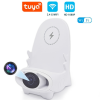Uncategorized
The Birth and Principle of Night Vision Camera: From Battlefield Night to Visual Revolution of Modern Science and Technology
First, the historical origin: the “eye of the night” spawned by the war
On the eve of the outbreak of World War II in 1939, in the laboratory on the outskirts of Berlin, Germany, physicist Walter Shutkey led the team to amplify the weak light signal in a vacuum tube. This seemingly basic research unexpectedly started the journey of human conquest of darkness. In 1943, the German army deployed the “Vampire” single soldier night vision device for the first time on the eastern front battlefield. Although this giant weighing 15 kilograms can only observe 150 meters, it marks that night vision technology has officially entered the historical stage.
On the allied side, the “Sniper Mirror T-120” urgently developed by the US Army Signal Corps on the eve of the Normandy landing in 1944 is driven by a 30,000-volt high-voltage power supply, which can magnify the moonlight by thousands of times. Although these early equipments were bulky and inefficient, they proved the feasibility of photoelectric conversion technology. During the Cold War, the US-Soviet arms race promoted technological iteration. In 1958, the first generation of AN/PVS-1 night vision equipment installed by the US military dropped its weight to 2 kg and its sight distance exceeded 400 meters.
Second, the core principle: the magical conversion of photons to electrons
The core of night vision technology lies in the three-stage energy conversion system:
Photon trapping layer: GaAs photocathode converts photons into electrons, and the quantum efficiency reaches 30% (the third generation technology), far exceeding the early silver cesium oxide material (less than 1%). Microchannel plate (MCP), like an electronic amplifier, achieves a gain of ten million times through secondary electron emission in a channel with a diameter of 6 microns.
Space-time compression technology: the third generation adopts gated power supply system, which can accurately capture nanosecond optical pulses, and dynamically adjust the gain with automatic gating technology to protect the equipment when strong light transits.
Multi-spectral fusion: Modern fourth-generation technology integrates near-infrared (0.7-1μm) enhancement and medium-wave infrared (3-5μm) thermal imaging, and realizes multi-spectral image fusion through deep learning algorithm, which can still generate clear images in completely dark environment.

Third, the key nodes in the technological breakthrough
When Gith Horst of Philips Laboratories in the Netherlands invented the prototype of image intensifier tube in 1934, he probably didn’t expect that this vacuum device would change the form of war. In 1962, the breakthrough application of microchannel plate reduced the size of the equipment by 80% and improved the resolution to 30lp/mm.. In the “Desert Storm” operation of the US military, the third-generation night vision device kept the tank troops advancing at a speed of 40 kilometers per hour in the sandstorm, and the advantage of one-way transparency in the battlefield was fully demonstrated.
In 2010, the breakthrough of graphene photocathode in the laboratory increased the quantum efficiency to 60% and the response band to 1.5 μ m. In the civil field, the STARVIS 2 sensor introduced by Sony in 2021 can still output color images under the illumination of 0.0005lux, which promotes the security monitoring to enter the era of full-time intelligence.
Fourth, from military secrets to people’s livelihood applications
After the Clinton administration declassified some night vision technologies in 1994, the civil market broke out. The wide dynamic night vision system carried by modern fire fighting robots can penetrate thick smoke in a fire at 2000℃. Wildlife researchers used ultra-low illumination cameras to record the nocturnal predation behavior of clouded leopards for the first time. In 2023, the space-class night vision equipment carried by SpaceX starship realized the exploration operation in the permanent shadow area of the moon.
This technology, which originated from the war, finally shines in the field of protecting life and exploring the unknown. From vacuum tubes to quantum dots, from monochromatic imaging to multispectral fusion, the journey of human beings to break through the visual limit is still moving towards deeper darkness.








